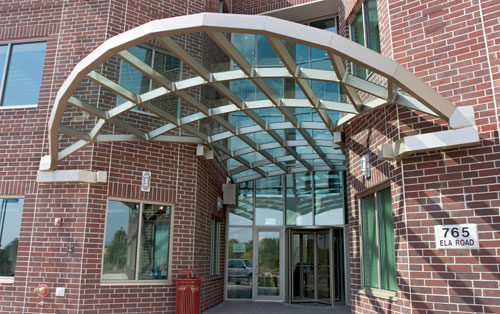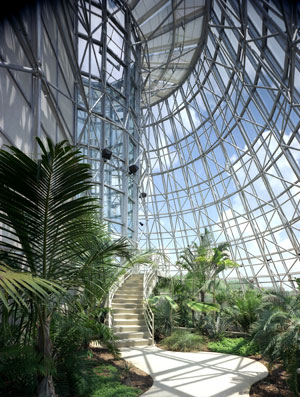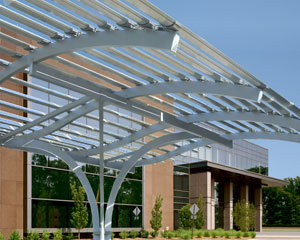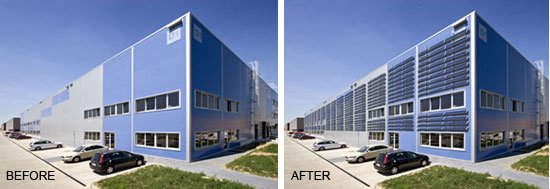Aluminum: A Sustainable Structural Choice
Single Layer Aluminum Tubes

Photo courtesy of CST COVERS
Utilizing structural aluminum tubes, this curved entry canopy is only six inches deep. Curvature can eliminate the need for three dimensional framing, as shown here. It is fifty feet wide and thirty feet deep and the design can support the required 160 PSF snow load.
Aluminum can also be used in smaller span structures, as it allows for cantilevers and extensions of the material that would not be possible with a heavier structure. skylights can be designed using a single layer aluminum tubes without the need for steel sub-frames. Utilizing structural aluminum tubes, this curved entry canopy in Eau Claire, Wisconsin is only six inches deep. It is fifty feet wide and thirty feet deep and the design can support the required 160 PSF snow load.

Photo courtesy of R. Greg Hursley
These large botanical spaces designed by Emilio Ambasz are clad with large glass panels connected directly to the structural members by use of an aluminum purlin system.
Custom Nodes and Cladding Materials
The design of a space frame and its components includes the connectors or nodes that are used to join members and designed to carry loads. These connectors can be shaped to fit almost any profile. For example, a linear node system will allow the space frame to have a very flat structure that can be used both in an overhead or vertical wall system. Custom extrusions with rigid joints, tubular members and small node connectors can also allow glass to be flush mounted. Design professionals should consult aluminum fabricators at initial design phases. Fabricators can propose a variety of structural configurations and analyze the most efficient connections and structural forms to achieve the best sustainable design solution.
Aluminum structural systems are designed to support any cladding system available in the market. As seen in the large botanical spaces designed by Emilio Ambasz (The Lucille Halsell Conservatory at the San Antonio Botanical Gardens), spaceframes can be clad with large glass panels connected directly to the structural members by use of an aluminum purlin system. This structure encloses an environment which is high in humidity. The plants are misted daily. The advantage of the aluminum frame is that it will not corrode and maintains its appearance. Aluminum can also be clad in translucent panels or engineered to receive tension fabrics. Aluminum structures are the clear choice for designers engineering solar panels to clad roofs, walls and freestanding solar systems.












